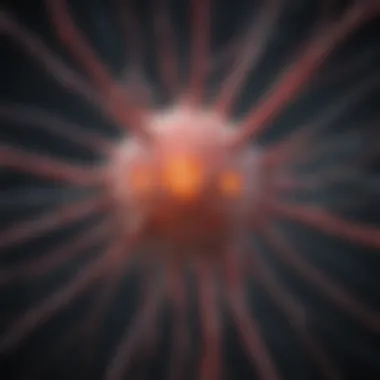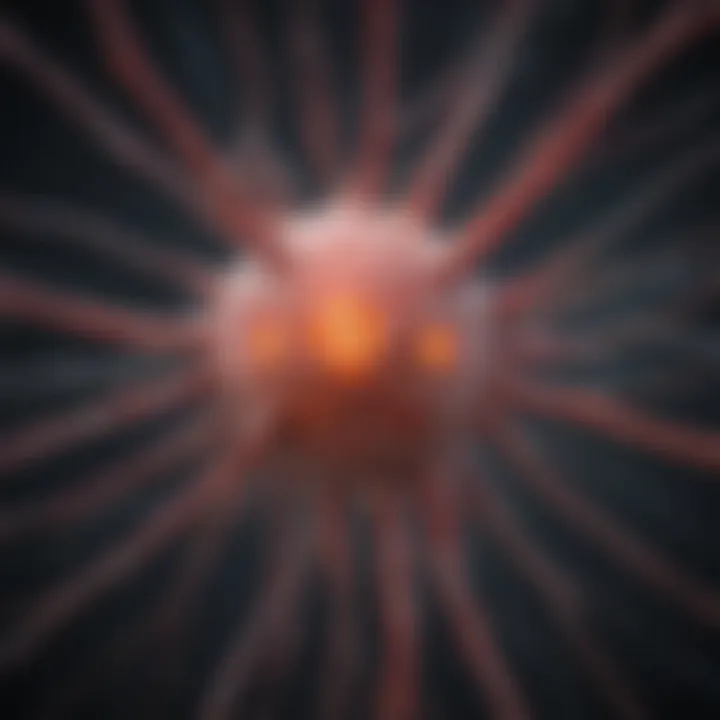Neurological Itching: A Comprehensive Analysis


Intro
Neurological itching is a condition that often goes unnoticed in both clinical and academic discussions. Patients may describe sensations that don’t directly correlate with classic pruritus, leading to confusion among healthcare professionals. This article serves to shed light on the intricacies of neurological itching, clarifying its mechanisms and implications for treatment.
Understanding neurological itching requires an exploration of its underlying neurological pathways. Through an interdisciplinary approach, researchers are beginning to unravel not only how these sensations occur but also how they can be managed effectively.
Research Overview
Key Findings
Recent studies have pinpointed several key factors related to neurological itching. These include:
- Neuropathic mechanisms: Many cases of neurological itching stem from dysfunction in peripheral or central nervous systems.
- Psychosomatic factors: Psychological stress and conditions, such as anxiety, can exacerbate these sensations.
- Co-existing dermatological conditions: Certain skin diseases can show overlapping symptoms, complicating diagnosis.
These findings underscore that neurological itching is multifaceted, demanding thorough research and clinical awareness.
Study Methodology
Various methods have been employed to study this condition:
- Qualitative surveys: Gathering personal accounts from patients provides valuable insights.
- Clinical trials: Testing new treatment approaches can establish the efficacy of different modalities.
- Neuroimaging: Advanced imaging techniques have been utilized to observe brain activity in response to itching sensations.
Research in these areas continues to develop, pointing to the growing acknowledgment of neurological itching as a legitimate and complex condition.
Background and Context
Historical Background
The concept of itching has been around for centuries, but neurological itching is a relatively recent area of focus. Early studies often conflated itching with other dermal reactions, overlooking its neurological foundations. This shift is essential for appropriate treatment strategies and improved patient outcomes.
Current Trends in the Field
As our understanding of the brain and nervous system evolves, the study of neurological itching is gaining traction. Important trends include:
- Interdisciplinary collaboration: Neurologists and dermatologists increasingly work together, recognizing that skin sensations often have neurological ties.
- Growing awareness in mental health: Researchers are emphasizing the psychological aspects that can influence perceptions of itching.
- Enhanced treatment methods: New therapies, including neuromodulation and psychotherapeutic strategies, are being explored more rigorously.
"Neurological itching challenges traditional views of how we understand and treat itch disorders."
The journey from a misunderstood symptom to a recognized condition reflects the ongoing evolution in both research and clinical practices.
Finale
This exploration lays the groundwork for deeper insights into neurological itching. Understanding its mechanisms, historical context, and the latest trends is crucial for healthcare professionals. By continuing to investigate this complex phenomenon, we can improve diagnosis, management, and ultimately, patient quality of life.
Defining Neurological Itching
Understanding neurological itching is vital for both clinical practice and academic research. This section provides critical insights into what neurological itching encompasses. Distinguishing it from standard pruritus aids in better assessment and treatment options.
Understanding Itching
Itching, or pruritus, is a complex sensation that prompts an urge to scratch. It can originate from the skin, but when it is classified as neurological itching, it stems from the nervous system rather than dermatological triggers. It can manifest in various forms and locations throughout the body. Neurological itching can often confuse both patients and practitioners, as it might not always correlate with visible skin lesions or irritations. This makes identification and appropriate management challenging.
Common causes of neurological itching include:
- Peripheral neuropathies
- Central nervous system disorders
- Multiple sclerosis
- Diabetes-related complications
Consequently, the understanding of itching extended beyond dermatology, delving into the complexities of neurobiology, thereby enriching medical knowledge in both fields. Understanding these distinctions is essential for both diagnosing and managing patients effectively.
Neurological vs. Dermatological Itching
Neurological itching differs markedly from dermatological itching in its origins and implications. Dermatological itching typically results from skin conditions such as eczema, psoriasis, or allergic reactions. In contrast, neurological itching arises from dysfunction in the nervous system. This differentiation is crucial for establishing effective treatment plans.
Key comparisons include:
- Causes: Neurological itching can be secondary to nerve damage, while dermatological itching arises from inflammatory skin conditions.
- Symptoms: Patients with neurological itching may report sensations that are less localized and more systemic, unlike dermatological itching, which is often confined.
- Treatment: Treatments for neurological itching may involve targeting the underlying neurological conditions, whereas dermatological itching tends to require topical treatment or antihistamines.
Understanding these distinctions is crucial for accurate diagnoses and optimized therapeutic approaches.
"Neurological itching necessitates a thorough understanding of neural pathways and their influence on sensory perception, emphasizing the importance of interdisciplinary approaches in questioning the nature of such itch."
By grasping the essentials of neurological itching, we can open pathways for better research and clinical procedures aimed at improving patient outcomes in both neurology and dermatology.
Neurological Mechanisms of Itching


Understanding the neurological mechanisms behind itching is critical for untangling the complexities of neurological itching. This topic is essential because it lays the foundation for recognizing how the nervous system processes the itch sensation. By delving into these mechanisms, we can better comprehend the clinical presentations of this phenomenon and the implications for treatment strategies. Moreover, understanding the pathways involved can shed light on potential therapeutic targets for managing neurological itching more effectively.
Nerve Pathways Involved
The nerve pathways associated with itching are intricate and multifaceted. At the skin level, specialized nerve fibers called C-fibers play a crucial role. These fibers are responsible for transmitting itch signals to the spinal cord, where they synapse with second-order neurons. From there, the itch sensation ascends to various brain regions, including the thalamus and the somatosensory cortex.
Some key elements of the nerve pathways include:
- Primary Afferents: These are the first responders in the itch pathway, delivering signals from the skin to the spinal cord.
- Spinothalamic Tract: This is a critical pathway that conveys nociceptive and pruritic information to the brain, integrating sensory inputs.
- Central Nervous System: Once in the brain, the sensation of itch is processed and perceived. This perception is refined by emotional and cognitive inputs.
Understanding these pathways not only deepens our insight into the sensation of itching but also helps identify where dysfunction might occur, potentially leading to therapeutic interventions.
Role of Neurotransmitters
Neurotransmitters are pivotal in modulating the sensations of itching and discomfort. Several key neurotransmitters are involved in this process, fostering communication between neurons during the itch response. Some crucial neurotransmitters include:
- Histamine: Often associated with allergic reactions, histamine is released by mast cells in the skin and binds to receptors on sensory neurons, triggering itch.
- Serotonin: In addition to its well-known effects on mood, serotonin can also enhance the sensation of itch, complicating the clinical picture in patients suffering from certain neurological conditions.
- Substance P: This neuropeptide is released during inflammation and plays a significant role in transmitting pain and itch signals.
- Calcitonin Gene-Related Peptide (CGRP): This is another neuropeptide that is implicated in itch sensation, particularly in inflammatory conditions.
The interplay between these neurotransmitters creates a complex framework where various stimuli can provoke or alleviate itching sensations. Thus, targeting these neurotransmitters may offer new avenues for treating patients with persistent or severe neurological itching.
"A comprehensive understanding of nerve pathways and neurotransmitter roles can lead to innovative treatments for managing neurological itching."
Clinical Presentations of Neurological Itching
Understanding the clinical presentations of neurological itching is critical for professionals dealing with this condition. Neurological itching is often misunderstood, as it can manifest in various forms. Recognizing these presentations can improve diagnosis and treatment strategies. Evaluating differences in presentation helps clinicians distinguish between neurological and dermatological causes of itching.
Local vs. Generalized Itching
Local itching refers to itch sensations confined to a specific area of the body. This type of presentation often points to localized neural pathways or lesions. For example, conditions such as multiple sclerosis can cause localized neurological itching due to nerve damage in a particular area. Patients might find relief through targeted treatments that address the local neural mechanisms involved.
On the other hand, generalized itching involves a widespread sensation across the body. This may indicate a more systemic issue, potentially linked to central nervous system disorders. Patients with generalized itching often face significant discomfort, impacting their daily functioning. Understanding this distinction enlightens clinicians about the potential underlying causes, leading to better-targeted interventions.
Chronic vs. Acute Manifestations
Chronic manifestations of neurological itching are persistent and can significantly diminish a patient's quality of life. These are usually difficult to treat and can be associated with conditions such as neuropathy or central sensitization. Patients may report episodes that last for months or years, which can create emotional distress and frustration. Management often requires a multidisciplinary approach, integrating pharmacological treatments with psychological support.
Acute manifestations, conversely, are short-term episodes triggered by specific events, like an injury or inflammation. These events can activate the nervous system temporarily, leading to a sudden sensation of itching. Acute episodes can be easier to manage if the underlying cause is identified swiftly. Understanding the difference between chronic and acute manifestations assists healthcare providers in formulating appropriate treatment plans.
"Experiencing neurological itching can disrupt daily life, but understanding its presentations forms the bedrock of effective management."
Psychological Aspects of Itching
The psychological aspects of itching play an essential role in the comprehensive understanding of neurological itching. Itching is not merely a physical sensation; it deeply intertwines with emotional and mental health. Recognizing these connections enables healthcare professionals to address the condition holistically, factoring both physical and psychological dimensions into patient care. Understanding the psychological determinants of itching can allow for tailored treatment strategies that significantly enhance the overall well-being of individuals affected by this condition.
Impact of Mental Health
Mental health conditions often exacerbate the experience of itching. Disorders such as anxiety and depression may amplify the perception of itch and influence its chronicity. When individuals are not psychologically well, their bodies may react differently to stimuli, leading to increased discomfort. Chronic itching can lead to a negative feedback loop where individuals become anxious about their sensation, which can then intensify perceptions of itch. Research has suggested that mental health issues can serve as both a precipitating factor and a byproduct of chronic itching, complicating diagnosis and treatment.
- Increased sensitivity: People suffering from anxiety might experience a heightened awareness of bodily sensations, including itchiness.
- Cycle of discomfort: Those with mental health conditions very often report heightened itchiness, leading to frustration and further exacerbating their mental state.
- Quality of life: Chronic mental health issues can significantly hinder a person's quality of life, trapping them in a cycle of itching and emotional distress.
In addressing these issues, clinicians need to integrate mental health assessments into their approaches when treating patients with neurological itching. Education about the mind-skin connection is vital for patients, as understanding these links may promote self-advocacy and better treatment compliance.
Stress and Its Effects
Stress is another critical factor influencing the experience of itching. When a person feels stressed, the body's response triggers the release of stress hormones like cortisol, which can affect skin health. Cortisol can modify inflammation processes and increase itch sensations. The relationship between stress and itching can also be cyclical—stress leads to itching, prompting more stress in response to discomfort.
- Emotional responses: Under stress, individuals may scratch their skin unconsciously, leading to potential injuries and secondary infections.
- Physical implications: Persistent scratching under stress can result in a vicious cycle of itch-scratch, complicating the condition further.
- Coping mechanisms: Effective stress management techniques can mitigate itch sensations, suggesting a need for integrated approaches in treatment.
Visualizing the stress-itch link is crucial: understanding that emotional responses can trigger and worsen itching empowers both patients and professionals to explore adaptive coping strategies. Overall, recognizing psychological aspects can unlock more effective, supportive interventions for individuals facing neurological itching.
Differential Diagnosis
Understanding the differential diagnosis of neurological itching is crucial for effective clinical management. It aids in distinguishing neurological causes from dermatological conditions and systemic diseases. This process ensures the appropriate selection of diagnostic tests and treatment strategies, allowing healthcare professionals to tailor their approach to individual patients.
Considering the overlapping symptoms among various conditions can greatly impact diagnosis. For instance, a patient may present with itching that appears skin-related but is actually of neurological origin. Accurate evaluation can prevent misdiagnosis and improve patient outcomes.
Neurological Disorders
Neurological disorders often feature itching as a significant symptom. Conditions such as multiple sclerosis, neuropathy, or even brain lesions can trigger abnormal itch sensations. Understanding the mechanisms at play is important. For instance, multiple sclerosis can disrupt nerve signaling. In neuropathy, damaged peripheral nerves may misfire, resulting in sensations of itch. Identifying these conditions necessitates a careful clinical assessment, often involving MRI scans or nerve conduction studies.
Skin Conditions


It is equally essential to consider dermatological conditions during the differential diagnosis process. Skin diseases like eczema, psoriasis, and dermatitis can present itching that mimics neurological origins. Evaluating the skin for rashes, scaling, or lesions can provide essential insights. Skin biopsies or scratch tests may also be warranted to rule out dermatological issues. Recognizing the distinction is imperative since these treatments differ significantly. Effective management of skin conditions may involve topical steroids, whereas neurological treatments may focus on addressing underlying nerve issues.
Systemic Diseases
Systemic diseases, including diabetes and liver dysfunction, can manifest as neurological itch. For example, diabetes-related peripheral neuropathy often results in itching, usually in lower extremities. Liver disease may lead to cholestasis, which can provoke itch via the accumulation of bile acids in the bloodstream. Thus, thorough blood tests and assessments of systemic involvement are essential in this context. Identifying these systemic factors can lead to holistic treatment approaches that address both the itch and its underlying causes.
"Differential diagnosis is not merely a list; it is a process that refines our understanding of complex symptoms."
The process of differential diagnosis surrounding neurological itching highlights the necessity for a comprehensive evaluation, encompassing skin conditions and systemic diseases. This multidimensional approach enhances the potential for effective treatment and patient care.
Impact on Quality of Life
Neurological itching significantly affects the quality of life for individuals who experience it. This type of itching can cause not only physical discomfort but also social and psychological challenges. Recognizing these impacts is crucial for understanding the full scope of the condition.
Social Implications
Individuals with neurological itching often face social dilemmas that stem from their discomfort. They may withdraw from social activities due to embarrassment or fear of judgement. This isolation can further exacerbate feelings of loneliness, which is a concerning outcome. For example, a person may avoid gatherings where they feel they cannot control their itch. This avoidance behavior can lead to a decrease in recreational and social interactions, which are vital for mental health and community engagement.
Moreover, the stigma associated with noticeable scratching or skin lesions can make it difficult for individuals to connect with peers and maintain relationships. Friends and family might not understand the nature of the condition, leading to misunderstandings. Thus, social implications of neurological itching create a ripple effect that impacts not just the individual but their loved ones as well.
Emotional Well-being
Emotional well-being is another realm profoundly affected by neurological itching. The persistent discomfort can lead to feelings of frustration and helplessness. This experience can trigger cycles of anxiety and depression among those affected. The constant battle against itching and its unpredictable nature imposes a burden that weighs heavily on mental health.
Patients may find themselves preoccupied with their condition, disrupting daily activities and diminishing overall life satisfaction. In addition, sleep disturbances caused by scratching or discomfort can result in fatigue, which negatively impacts emotional well-being. The intersection between physical pain and mental distress necessitates ongoing support and management strategies.
"Understanding the impact of neurological itching on quality of life is essential for developing effective treatments and support systems."
Thoughtful approaches that integrate both social and emotional supports are vital. Such strategies might include community support groups, psychological counseling, or rehabilitation initiatives that foster a holistic approach to management. Not only do these measures address the symptomatology of neurological itching, but they also significantly improve the quality of life for affected individuals.
Current Treatment Approaches
Understanding the current treatment approaches for neurological itching is vital for both patients and healthcare providers. Neurological itching often presents complex challenges, requiring a nuanced strategy for management. The treatment landscape includes both pharmacological treatments and non-pharmacological interventions. Each type has its own merits and considerations, making a well-rounded approach essential for effective care.
Pharmacological Treatments
Pharmacological treatments are often the first line of defense in managing neurological itching. These medications can target specific pathways involved in the sensation of itch, providing relief to affected individuals.
- Antihistamines: -antihistamines, in particular, are commonly used in cases where allergic reactions may contribute to itching. They work by blocking the action of histamine, which can reduce itch sensations. Second-generation antihistamines like cetirizine may be preferred due to fewer sedative effects.
- Neuromodulators: Medications such as gabapentin and pregabalin have gained attention in managing chronic itch. They target nerve pain and can help in altering the itch perception by affecting neurotransmitter release.
- Topical Agents: Corticosteroids can be effective for localized itching. They reduce inflammation, which can decrease the feeling of itch. However, prolonged use carries risks of skin thinning and other side effects.
- Calcineurin Inhibitors: Tacrolimus and pimecrolimus creams serve as alternative treatments, especially for itch associated with certain skin conditions. These agents modulate immune response without the risks associated with long-term steroid use.
- Opioid Receptor Modulators: Some research suggests that targeting opioid receptors could help manage neuropathic itching. Agents like nalfurafine, although primarily used in renal conditions, show promise in reducing itch intensity.
The effectiveness of pharmacological treatments can vary depending on the individual patient, their underlying conditions, and response to medications.
Non-pharmacological Interventions
Non-pharmacological interventions also play a crucial role in managing neurological itching. These approaches focus on lifestyle modifications and alternative therapies that can enhance patient comfort while minimizing side effects.
- Moisturizers: Maintaining skin hydration can be key in managing itch. Non-irritating moisturizers help soothe the skin and can reduce the frequency and intensity of itching.
- Psychological Interventions: Cognitive-behavioral therapy (CBT) can address the psychological components associated with chronic itching. Stress management techniques also improve overall well-being and may lessen itch perception.
- Acupuncture: Some studies suggest acupuncture may offer relief in chronic itch cases. This traditional practice can stimulate specific points, potentially altering the nerve signaling involved in itch perception.
- Heat and Cooling Treatments: Patients often find that hot water can aggravate itch for some types, while cool baths can provide temporary relief. Adjusting water temperatures during bathing can be a simple yet effective measure.
- Dietary Modifications: Some patients report that certain foods may trigger or worsen their itching. Keeping a food diary can help identify allergens or irritants, leading to a more tailored dietary approach.
- Behavioral Strategies: Encouraging the avoidance of scratching, which can worsen skin conditions, is vital. Strategies such as wearing gloves or using barrier creams can help break the cycle of itching and scratching.
Incorporating both pharmacological and non-pharmacological treatments is often necessary to achieve optimal outcomes in managing neurological itching.
Overall, treatment approaches should be individualized to meet the unique needs of each patient, considering the specific causes and contributing factors of their neurological itching.
Emerging Research and Developments
Emerging research on neurological itching reveals intricate connections between various neurological mechanisms and itching sensations. New findings help broaden the understanding of the condition, with implications for treatment and patient care. The role of cutting-edge studies cannot be understated, as they add depth to existing knowledge. Researchers are increasingly focused on how neurological conditions influence sensations, including itching.
Understanding these developments provides insights into better management techniques and enhances the potential for targeted therapies in the future. The interplay between basic science and clinical application remains vital in this field.
Recent Studies on Neurological Itching
Recent studies have started to shed light on specific mechanisms behind neurological itching. A significant work involved examining the relationship between peripheral and central pathways, offering a glimpse into how itching signals are interpreted by the brain. These pathways are crucial in both acute and chronic conditions.
For example, a study published in Journal of Neuroimmunology investigated chronic itch in patients with neurological disorders. Findings suggested that transmission of pruritus signals may occur through the same pathways as those involved in pain signaling. This overlap provides a basis for understanding why some patients experience heightened sensations of itch alongside other neurological symptoms.
Moreover, studies focusing on neurotransmitters like substance P and calcitonin gene-related peptide (CGRP) demonstrate their role in mediating itch responses. These insights not only enhance comprehension of the condition but also pave the way for developing targeted pharmacological interventions.
Future Directions in Research
Future research on neurological itching should aim to expand the current knowledge base. One promising area is the investigation of genetic and molecular factors that contribute to individual susceptibility to neurological itching. Understanding these factors may lead to new biomarkers for diagnosis.
Additionally, clinical trials exploring innovative treatment methods hold potential. This includes examining the efficacy of neuro-modulating therapies, which could provide relief for those with chronic itch. Studies should also explore the impact of psychosocial factors on the perception of itch, given the links highlighted in previous sections.


In summary, further studies are essential. They can either confirm existing hypotheses or unveil new pathways and mechanisms involved in neurological itching. Collaboration between neurology and dermatology will enhance understanding and ultimately contribute to improved therapeutic strategies.
Interdisciplinary Perspectives
The study of neurological itching encompasses a wide range of disciplines, highlighting the necessity of an interdisciplinary approach. Exploring how different fields interact provides a deeper understanding of this complex condition. Neurology, dermatology, psychology, and even social sciences play crucial roles in comprehending and managing it. This collaborative model is essential to ensure that patients receive comprehensive care that addresses both their physical and psychological needs.
Importance of Collaboration
Collaboration between specialists not only enhances diagnostic accuracy but also improves treatment outcomes. Neurologists possess expertise in the nervous system and can identify neurological conditions that may provoke itching. On the other hand, dermatologists focus on skin-related issues and can address any cutaneous symptoms associated with the itching. When these two fields collaborate, patients benefit from a well-rounded treatment plan, reducing the chances of overlooking important details that could affect patient care.
Collaboration Between Neurologists and Dermatologists
Effective management of neurological itching often demands coordinated efforts among neurologists and dermatologists. Each specialist brings unique insights to the table. Neurologists can help discern the underlying neurological mechanisms that contribute to itching, identifying problems like multiple sclerosis or neuropathy. Dermatalogists, however, can evaluate the skin's condition and offers treatment options like topical therapies integral to the management process.
"An integrated approach leads to more accurate diagnoses and holistic treatments that consider the whole patient, rather than just isolated symptoms."
Benefits of Interdisciplinary Care:
- Comprehensive Assessment: Both specialists conduct thorough examinations, leading to a complete understanding of the patient's condition.
- Tailored Treatment Plans: Treatments can be customized based on an in-depth understanding of both neurological and dermatological factors.
- Improved Patient Satisfaction: Patients receiving interdisciplinary care often report higher satisfaction due to the holistic view taken on their health.
Insights from Psychological Research
Psychological factors significantly influence the experience of neurological itching. Recent psychological research emphasizes that emotional states can exacerbate the perception of itching. Anxiety and depression could lead to increased sensitivity, intensifying the itching sensation. It is essential to acknowledge this connection between the mind and physical symptoms.
Incorporating psychological insights into treatment plans can improve patient outcomes. Cognitive behavioral therapy (CBT) techniques, for instance, can help patients cope with the neurological itching's psychological emotion links. Understanding these dynamics enriches the management strategies deployed by healthcare professionals.
Key Considerations:
- Mental Health Assessment: Regular screenings for psychological conditions should be part of the patient evaluation protocol.
- Holistic Treatment Strategies: Integrating therapy options can relieve both itching sensations and the emotional distress related to them.
- Patient Education and Support: Informing patients about the connection between their mental health and itching can empower them in their treatment journey.
Case Studies
Case studies play a crucial role in expanding the understanding of neurological itching. They allow for a detailed observation of individual patient experiences and the complexities that can accompany this condition. Each case provides unique insights that often elude broader statistical studies, which tend to focus on common patterns and trends.
The significance of case studies lies in their ability to highlight specific symptoms, triggers, and responses to treatment that may not be widely recognized. Through these examples, healthcare professionals and researchers can better grasp the variability in clinical presentations. By observing how different individuals react to neurological itching, it becomes clearer how interconnected the neurological, dermatological, and psychological components are.
Illustrative Examples
Illustrative examples from case studies can demonstrate the diversity of neurological itching presentations. For instance, one patient may experience localized itching due to a specific neurological condition, such as multiple sclerosis, while another might illustrate how stress exacerbates itching across the body. In different scenarios, one might show how a stroke leads to heightened itch perception without an associated skin condition, while another may reveal the challenges faced by patients with phantom limb syndrome who report intense itching in a missing limb.
These examples not only document the physical sensations of itching but also capture the emotional and psychological toll it takes on individuals.
Lessons Learned
The lessons learned from case studies are vital for improving patient care. One key takeaway is the importance of personalized treatment approaches. What works for one patient may not work for another, illustrating the necessity for tailored management strategies.
Additionally, these case studies can inform healthcare providers about potential triggers and coping mechanisms. By analyzing various cases, practitioners can develop a nuanced understanding of how psychological factors correlate with neurologic conditions, leading to better patient outcomes.
"Every individual case adds depth to our knowledge and understanding of neurological itching, stressing the need for an individualized approach in treatment and care."
Finally, case studies emphasize the need for ongoing research. Despite advances in medicine, many aspects of neurological itching remain poorly understood. Documenting real-world experiences helps to identify gaps in knowledge and potentially inspires new avenues for investigation.
Patient Management Strategies
Patient management strategies are crucial in the context of neurological itching. These strategies focus not only on alleviating symptoms but also on understanding the underlying causes and how they interact with the patient’s overall health. The aim is to provide a comprehensive approach that considers both physical and psychological factors.
The holistic view is more beneficial than isolated treatments. Effective management often requires a multidimensional approach involving healthcare providers from different specialties, including neurologists, dermatologists, and mental health professionals. This collaboration ensures that all aspects of the patient's condition are addressed appropriately.
Additionally, patient management strategies help in tailoring treatment plans specific to individual needs. The strategy can include pharmacological treatments, lifestyle modifications, and psychological support. Ultimately, addressing these various elements fosters better patient outcomes and enhances the quality of life for individuals dealing with neurological itching.
Holistic Approach
A holistic approach to managing neurological itching considers the patient as a whole rather than focusing solely on the itching sensation. This method integrates various treatment modalities to address physical, emotional, and environmental factors. It recognizes that itching may not just be a symptom of a neuropathic condition but may also be influenced by stress, anxiety, and body perception.
The benefits of such an approach include:
- Personalized Care: Treatment plans can be customized based on specific patient needs and conditions.
- Improved Mental Health: Addressing psychological aspects can lead to reduced stress and anxiety, which may alleviate itching symptoms.
- Enhanced Communication: Collaboration among different healthcare specialists fosters better communication, ensuring that all patient concerns are addressed.
Through techniques like mindfulness, behavioral therapy, and even yoga therapy, practitioners can help patients manage their symptoms more effectively. In this manner, a holistic approach can significantly enhance the overall wellbeing of the patients involved.
Education and Support
Education and support play a vital role in the management of neurological itching. Providing patients with clear, accessible information about their condition empowers them to understand their symptoms better and the various treatment options available.
Support systems such as patient support groups or online forums can facilitate sharing experiences and coping mechanisms among individuals facing similar challenges. These platforms not only offer emotional support but also provide valuable insights on what has been beneficial for others.
Important elements of education and support include:
- Information on Neurological Itching: Understanding the mechanisms behind the condition helps demystify the experience for patients.
- Resources for Self-Management: Patients can be guided on techniques that might relieve their symptoms, such as skin care routines or relaxation methods.
- Encouragement for Open Dialogue with Healthcare Providers: Patients should feel encouraged to discuss their concerns, share progress, and seek adjustments in their treatment plans whenever necessary.
"An informed patient is often a more engaged and proactive one in their healthcare journey."







